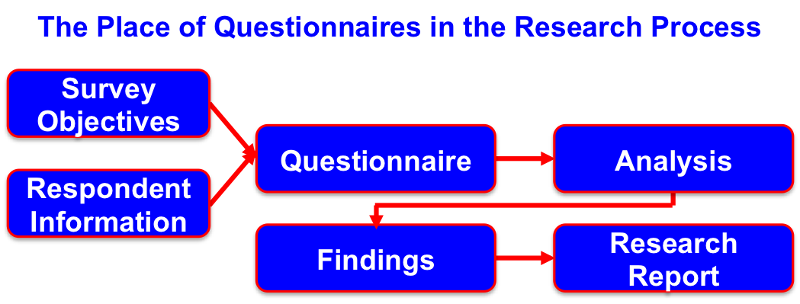What is a Questionnaire?
A questionnaire, or survey instrument, is a series of questions designed to elicit information from respondents that relate to the marketer's research question. Questionnaires are administered by surveying respondents. A questionnaire must fulfill four basic tasks:
- Collect appropriate data that meet the research objectives
- Make data available for analysis
- Minimize the bias, or distortions, caused by poorly worded questions and improper survey administration
- Make the questions varied and engaging to eliminate respondent fatigue[1]
Questionnaires standardize data collection. Every respondent is asked the same question. Researchers develop questionnaires based on the survey objectives, which are developed from the understanding of the research problem and the selected pool, or sample, of respondents. As such, questionnaires play a critical role on the Marketing Research process. Questionnaires are a critical tool for Descriptive and Causal Marketing Research.
An effective questionnaire is based on the survey objectives and is designed to elicit the needed data from respondents in a manner that does not introduce bias. From the researcher's perspective, bias is anything that distorts the findings.

Chart 1
What Makes a Questionnaire Effective?
An effective questionnaire meets the following criteria:
- It provides information that the decision-makers need
- It limits the sources of bias due to the structure of the questionnaire and its administration
- It elicits information from the respondents without stressing them
- It is designed for the manner in which the questionnaire will be administered. Surveys can be administered several ways:
- Face-to-face interviews administered by an interviewer
- Telephone interviews administered by an interviewer
- Respondent-administered interviews using a questionnaire printed on paper
- Respondent-administered interviews using an online questionnaire
- It is designed to make data analysis simple and less prone to error. The respondents' answers should be easily coded and edited to ensure that the questionnaires are properly administered and the answers recorded correctly.
Some Common Practices for Creating Effective Questionnaires
Most marketing researchers follow these guidelines for creating questionnaires:
- Work Collaboratively: Researchers collaborate with their clients to make certain the questionnaire will generate the information the client needs to make decisions about a marketing problem. A major part of this collaboration deals with defining the research and survey objectives, working within the budget and timetable, and considering whom to survey. If the budget is too small to conduct a survey or if there is not enough time to administer it, the researchers should not conduct the survey. In these cases, the client should rely on judgment or the findings from Exploratory Research.
- Follow the KISS Principle (KISS stands for: Keep It Simple, Stupid): Questions must be carefully written. To capture respondents' beliefs, thoughts, and feelings, simplicity is key. Respondents must understand it. Avoid jargon. Write in the respondents' vernacular.
- Choose a Method for Administering the Survey: There are a variety of ways to administer surveys: Face-to-face interviews, phone interviews, self-administered interviews online, self-administered interviews with questionnaires delivered through the postal service. Each has its advantages and disadvantages, which we will review later in this lesson.
- Repetition is good: Ask the same question two or three times, but phrase the questions differently. Too much repetition, however, leads to long questionnaires. Long questionnaires can be burdensome for respondents.
- Screen Respondents: Even the most carefully developed survey selects unqualified respondents. Good questionnaires ask screener questions to filter out unqualified respondents.
- Test the Questionnaire: Smart researchers conduct a pilot test of the questionnaire among a small sample. The purpose of pilot testing is to determine whether questions should be reworded, reordered, or eliminated.
[1] Respondent fatigue is a well-documented phenomenon that occurs when survey participants become tired of the survey task and the quality of the data they provide begins to deteriorate. Lavrakas, Paul J. (2008), Encyclopedia of Survey Research Methods, http://srmo.sagepub.com/view/encyclopedia-of-survey-research-methods/n480.xml
toc | return to top | previous page | next page

